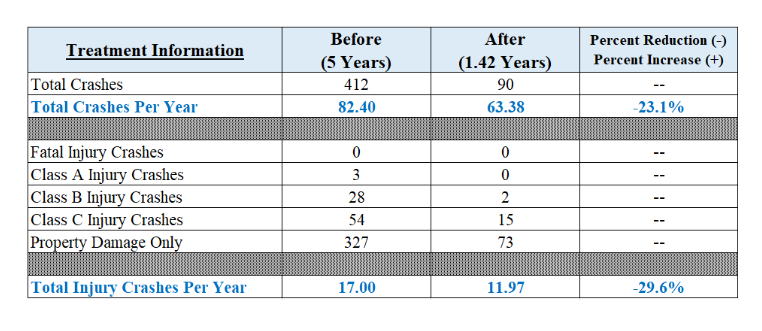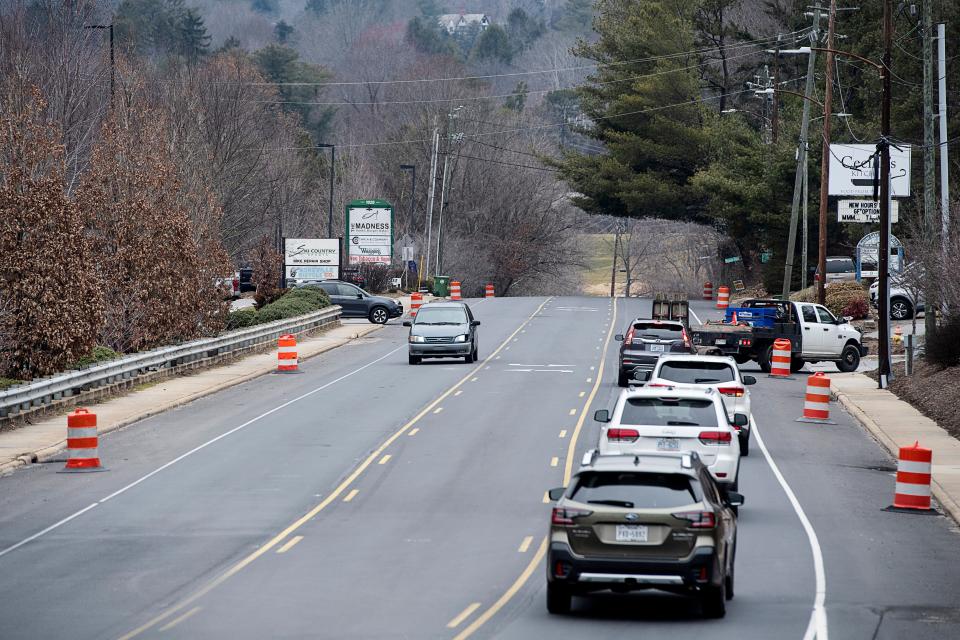NCDOT: Asheville Merrimon Avenue road diet early data is in: What does it show?
ASHEVILLE - Preliminary data from the Merrimon Avenue road diet returned largely positive results, N.C. Department of Transportation engineers say, with a reduction in total crashes, slower speeds, more cyclists along the corridor and an increase in average travel times of 2-14 seconds at peak evening hours.
The road diet for the central Asheville corridor was the subject of contentious debate. It was approved in May 2022 by Asheville City Council and resulted in the conversion of a section of Merrimon Avenue from four lanes to three, adding 5-foot bike lanes along both sides of the road.
An NCDOT resurfacing project, it impacted about 2.5 miles of Merrimon Avenue from I-240 to Midland Road at Beaver Lake. While the entire stretch was repaved and restriped, only the northern section, from W.T. Weaver Boulevard to Midland Road, was subject to the road diet.
The project began in October 2022 with the lane conversion, but work persisted for months as crews milled, resurfaced and repaved the road, bringing curb ramps into ADA compliance and finalizing drainage work. The bulk of the work was finished by February 2023, but the project was officially completed in May 2024 with the optimization of the traffic signals, said Hannah Smith, NCDOT Division 13 planning engineer.

Looking at the early metrics, she told the Citizen Times July 1 that they are viewing the project as a "success." Smith said it was intended as a safety project for all motorists, not just pedestrians and cyclists, and that they always expected a tradeoff in capacity and travel time for safety benefits.
NCDOT Safety Evaluation Engineer Carrie Simpson reported preliminary numbers to the city's Multimodal Transportation Commission June 26.
"I was really happy to hear that what we had hoped was confirmed by the data," said council member Maggie Ullman, the commission's liaison, of the reported improvements.
"The corridor is safer for all modes. And we're seeing that here, in our community."
Safety metrics?
Safety data is "generally positive," Simpson said, with reductions in reported crashes on the four- to-three lane conversion section.
Crash datasets were pulled using the Traffic Engineering Accident Analysis System, which contains information on all reportable traffic crashes occurring in North Carolina, according to NCDOT.
Preliminary safety data shows a 23% reduction in total crashes and a 30% reduction in injury crashes on Merrimon Avenue within the road diet area, as well as slight reductions in total crashes for the sections to the north and south, Simpson said.
Short term trends when examining "crash types" suggest a reduction in frontal impact crashes, down 55% — which includes head-on, angle, left-turn and right-turn crashes — and an increase in rear end crashes, up 67%. Overall it is a "safety win," she said, as front impact crashes typically result in injury.
For the five-year "before" period, from October 2017 to September 2022, there were nine reported pedestrian crashes and two reported bicycle crashes, resulting in 10 injuries of varying severity, and one property damage crash only.
In the "initial after" window, 1.42 years, from October 2022 through February 2024, there was one reported pedestrian crash and one reported bicycle crash, both of which resulted only in property damage.

The presentation noted the roadway was still under construction for part of the "initial after" window.
Safety data is also being studied on alternate routes, Simpson said, and preliminary results for total crashes vary, with a slight increase on Broadway Street, no change on Kimberly Avenue, and a reduction on Lakeshore Drive. Injury crashes showed reductions for all three routes.
Speed, travel metrics?
For the entire 4-mile Merrimon Avenue corridor, average travel times ranged from 8-10 minutes. The following changes were reported by NCDOT:
Northbound direction:
19 second reduction in average travel times at 9 a.m.
1 second reduction in average travel times at 1 p.m.
14 second increase in average travel times at 5 p.m.
Southbound direction:
No change in average travel times at 9 a.m.
8 second increase in average travel times at 1 p.m.
2 second increase in average travel times at 5 p.m.

Comparing datasets from September 2022 and October 2023, the average daily volume was down 1-8% — from 12,000 to 19,600 vehicles, as compared to 12,400 to 21,300. Just north and south of the road diet, Merrimon Avenue saw drops in average daily volume of 1-4%.
Speeds were reduced in the conversion section, Simpson said, dropping by an average of 3-5 mph, which can result in improvements for safety and the severity of crashes when they do occur.
Vehicle volumes were up on some nearby streets, like Broadway Street, Lakeshore Drive, and Woodward, Kimberly and Farrwood avenues, varying from 5-16%. The heaviest increase was on Kimberly, part of which runs parallel to Merrimon, with 600 to 900 more vehicles per day.
In studying adjacent routes, Simpson said the diverted traffic did not result in a significant increase in crashes for the corridors, but that it's something they would continue to watch.
How many cyclists?
Bicycle volumes increased in 11 of 12 data collection points, despite rainfall during some of the October 2023 observations, Simpson said. At the northern end of the treatment section, the number of cyclists increased 269%, up 35 bicyclists over two-day counts. Almost 700 bicyclists were counted in October, as compared to over 400 in September 2022.
Pedestrian volumes varied, with some locations showing increases and some decreases, NCDOT reported. Over 1,900 pedestrians were counted in October, as compared to almost 2,200 in September 2022. Simpson said rainfall likely played a role in the 2023 count.

Now what?
Simpson said more data collection will occur in the fall and NCDOT will have another summary of information early next year. The city's agreement with the department in 2022 included a removal clause if the project were to be reversed, and certain metrics that might result in that reversal. Simpson confirmed they have not met any of those metrics.
The presentation was met with positive reactions from the multimodal commission, with hope that the data might address some of the "trepidation" around the project.
"The narrative from a lot of people initially was that this was going to cause ... on the scale of minutes more (spent) trying to traverse this part of the roadway. So, to me, 2-14 seconds increase in the amount of travel time is worth all of the reductions in crashes and injuries," commission member Elyse Marder said. "I think having this data really just shows that the scale of what people thought was going to happen is not happening."
Ullman, who lives in North Asheville and travels Merrimon Avenue daily, said she doesn't see a "downside" to the project, and praised the partnerships between the city, NCDOT, the multimodal commission, community members and advocacy groups like Asheville on Bikes.
"This is a real success in what it looks like to work across jurisdictions and across the community to say, 'we're going to pilot something to try to make the community better, we're going to track it with data.' And if the data came back differently, we would be having a different conversation," Ullman said. "The data has proven that the pilot has been successful."
More: Merrimon Avenue: When will repaving begin? Are there bike lanes, or not?
More: Asheville City Council approves Merrimon Avenue road diet after contentious debate
Sarah Honosky is the city government reporter for the Asheville Citizen Times, part of the USA TODAY Network. News Tips? Email shonosky@citizentimes.com or message on Twitter at @slhonosky. Please support local, daily journalism with a subscription to the Citizen Times.
This article originally appeared on Asheville Citizen Times: Asheville Merrimon Ave. road diet early data results: What to know

